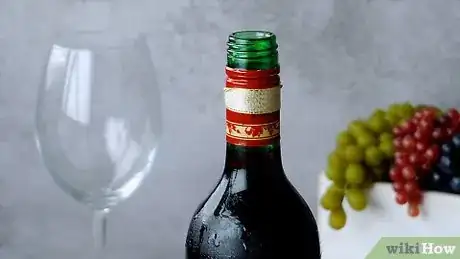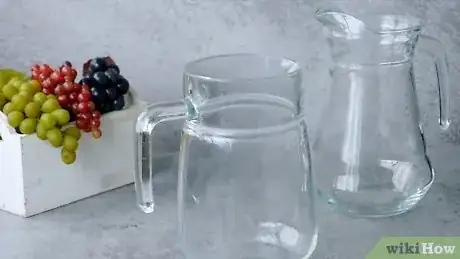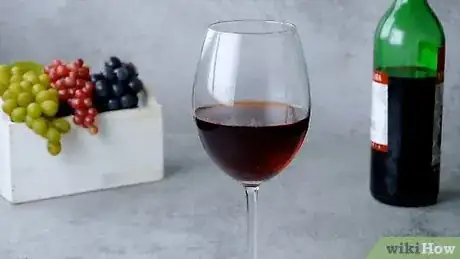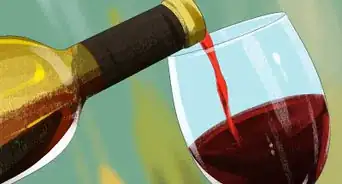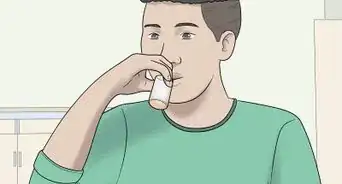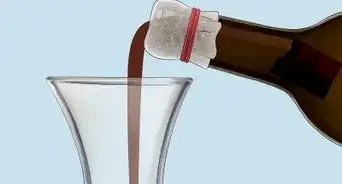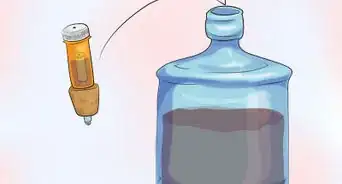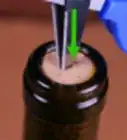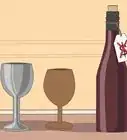This article was co-authored by Murphy Perng. Murphy Perng is a Wine Consultant and the Founder and Host of Matter of Wine, a business that produces educational wine events, including team-building experiences, networking events, and private parties. Based in Los Angeles, California, Murphy has served as a Wine Educator for clients such as Google, Buzzfeed, Tiktok, Snapchat, and Equinox and been featured on National Geographic and The Somm Journal. Murphy possesses her WSET (Wine & Spirit Education Trust) Level 3 Advanced Certification.
This article has been viewed 171,365 times.
If you're drinking a bottle of tannic red wine that is under eight years old, chances are that letting it breathe, or aerate, will improve its taste. Tannins are the chemicals that make wine astringent; they are what make your mouth pucker and feel dry after taking a sip. In older vintages, tannins break down in the bottle as the wine's bouquet evolves. In young, full-bodied reds, however, tannins can overwhelm a wine's more delicate flavors. Aerating wine lessens its astringency by breaking down its tannins and opening up its bouquet.
Things You Should Know
- You can easily aerate wine using a blender. It's as simple as putting the wine into the blender for 15-30 seconds, after which you can pour it in a glass and enjoy it.
- You can also aerate wine using two pitchers. By pouring the wine back and forth between the pitchers, it will become aerated.
- There are also many highly rated products that will aerate wine for you, including the Vintorio Wine Aerator, the TenTen Labs Wine Pourer, and the VinFlow5 Aerator Pourer.
Steps
Using a Blender
-
1Open up a bottle of red wine. If it is under eight years old, chances are, it will be slightly tannic. If the wine is older, it won't need any aeration.
-
2Pour the wine into a blender. If you do not have a blender, you can use a food processor with a blade attachment.Advertisement
-
3Close the blender and pulse it on high for 15 to 30 seconds.[1] This will help mix air into the wine and soften tannins. Don't worry if you see bubbles forming. This is simply the air bubbles, which will help aerate the wine.
-
4Pour the wine into wine glasses and serve. For a better presentation, you can also use a funnel to pour the wine back into its original bottle.
Using Two Pitchers
-
1Get two pitchers. You will be pouring the wine back and forth between the pitchers, so it might be a good idea to use ones that are lightweight and easy to handle.
-
2Pour a bottle of tannic red wine into the first pitcher. If the wine is under eight years old, it will probably be somewhat tannic and need aeration. If the wine is older than it, you won't need to aerate it.
-
3Pour the wine into the second pitcher. Don't worry about how fast or how slow you do this. You will be doing this repeatedly, which will help aerate the wine.
-
4Continue pouring the wine back and forth between the pitcher. Do this for a total of 15 times.[2]
-
5Serve the wine. At this point, you can pour the wine into the wine glasses, or you can pour it back into its original bottle. Place a funnel into the neck of the bottle first, so that you don't spill any wine.
Using a Wine Glass
-
1Choose a red wine glass with a large bowl. Red wine glasses are different from white wine glasses for a reason: to help aerate the red wine.
- If you are serving a larger number of people, you can use a red wine decanter instead.[3] Choose one with a larger bowl.
-
2Pour some tannic red wine into the glass. Stop pouring at the widest part of the glass. This will allow more of the wine to come in contact with the air. It will also prevent any sloshing or spilling when you swirl the wine.[4]
- As you pour, try to hold the bottle about 10 inches (25.4 centimeters) above the glass. This way, the wine will be exposed to more air on its way into the glass.
-
3Set the wine aside and let it breathe for at least 45 minutes.[5] The younger the wine is, the longer it will need to sit. For example, a young wine might need to sit for up to six hours, whereas an older wine might turn to vinegar after one hour.[6]
- If you are pouring an old, fragile, and mature wine, drink it within 30 minutes. Don't let it sit any longer than that.
- Lighter bodied red wines, such as pinot noir's, typically need only 15 to 20 minutes to breathe, if that.
-
4Swirl the wine in its glass and take a sip to test the flavor. Swirling the wine in the glass helps aerate it further.
Community Q&A
-
QuestionDo I aerate white wine?
 Community AnswerNo.
Community AnswerNo. -
QuestionHow do I make wines from red grapes in my home?
 Community AnswerCheck out the helpful tips in this article about how to make homemade wine on wikiHow.
Community AnswerCheck out the helpful tips in this article about how to make homemade wine on wikiHow.
Warnings
- Lighter bodied reds or whites may taste a bit harsh, a condition known as “bottle stink,” but this clears up after about 15 minutes of aeration.⧼thumbs_response⧽
- Don't uncork the bottle and let it sit for an hour. This is not very effective, because the narrow bottle neck will not allow enough air into the wine.[11]⧼thumbs_response⧽
- Don't attempt to aerate old, fragile, and mature wines. They should be drunk within 30 minutes of opening. If you leave them out too long, their flavor will spoil.[12]⧼thumbs_response⧽
Things You'll Need
Using a Blender
- Tannic red wine
- Bottle opener
- Blender
- Funnel (optional)
Using Two Pitchers
- Tannic red wine
- Bottle opener
- 2 pitchers
- Funnel (optional)
Using a Wine Glass
- Tannic red wine
- Bottle opener
- Red wine glass or decanter
References
- ↑ https://www.cooksillustrated.com/how_tos/6394-aerating-wine-in-a-flash
- ↑ https://www.cooksillustrated.com/how_tos/6394-aerating-wine-in-a-flash
- ↑ Murphy Perng. Wine Specialist. Expert Interview. 15 March 2019.
- ↑ http://bettertastingwine.com/taste.html
- ↑ http://www.wellesleywinepress.com/2009/07/wine-aerobics-why-you-should-aerate.html
- ↑ http://bettertastingwine.com/taste.html
- ↑ http://www.wellesleywinepress.com/2009/07/wine-aerobics-why-you-should-aerate.html
- ↑ http://www.wellesleywinepress.com/2009/07/wine-aerobics-why-you-should-aerate.html
- ↑ http://bettertastingwine.com/taste.html
About This Article
One of the easiest ways to aerate wine is with a blender. Start by opening the bottle of wine and pouring the contents into a blender or food processor. Next, close the blender and pulse it on high for 15 to 30 seconds to mix air into the wine and soften the tannins. Then, pour the wine into wine glasses and serve it, or use a funnel to transfer it back into the original bottle for a better presentation. For tips on using pitchers or wine glasses for aeration, read on!
